► Supercharger price-cut for non-Tesla owners
► Membership pricing now the same for all
► New £90 annual membership is 16% saving
Tesla has reduced its Supercharger membership pricing for owners of all electric vehicles, making it cheaper to charge at one of the leading EV charging networks in the UK. Tesla membership means that pricing at the plug is the same whether you own a Tesla or another that’s now able to use a significant portion of the Supercharger network.
Tesla owners still get an advantage, as they have membership automatically. For non-Tesla owners, the monthly membership cost has fallen from £10.99 to £8.99, which is at least a saving when the cost of everything else still seems to be going up. And Tesla has added a new annual subscription option, which at £90 for the year represents a further saving of 16 per cent.
Customers who already have a membership will automatically see their monthly fee reduced, or they can switch to the new 12-month plan. Though Tesla stresses you’ll need at least version 4.32 of the Tesla app for it to all work smoothly.
How much does it cost to charge at a Tesla Supercharger?
We’ve quoted an average figure lower down this page, but that’s a little misleading as Tesla Supercharging pricing now varies not only between individual Supercharge sites but also with the time of day.
For instance, when queried, Tesla provided CAR with the following examples for the popular Tottenham charging location:
Charging Fees for Tesla Owner
12:00am – 4:00am : £0.29/kWh
4:00am – 8:00am : £0.24/kWh
8:00am – 12:00am : £0.47/kWh
Idle fees (up to) £1/min
Charging Fees for Other EV Owner
12:00am – 4:00am : £0.39/kWh
4:00am – 8:00am : £0.32/kWh
8:00am – 12:00am : £0.63/kWh
Idle fees (up to) £1/min
To make life a little easier, there’s an official interactive map of Tesla Superchargers, which shows pricing info at each location and can be filtered to show just Superchargers that all EVs can use. However, it does seem to be a touch slow and clunky to use right now.
Tesla sells EV charging tech to third party for first time
Tesla has reached a deal to sell its electric vehicle charging stations to EG Group, the company that operates the fuel station forecourt chain Euro Garages. The agreement marks the first time that Tesla has sold its charging technology to a third party.
The chargers will feature EG Group’s ‘evpoint’ branding – and they’ll operate on an open network, meaning they’ll be available for use by all electric cars. The company hopes its partnership with Tesla will make it easier for drivers to make the switch to an EV for two reasons.
First, EG Group says its chargers will be incredibly easy to use. The charger will support the Plug and Charge protocol, which is an automated payment method that eliminates the need to fiddle with payment cards or smartphone apps at the plug. If your car’s compatible with the tech, the payment is taken automatically when you disconnect.
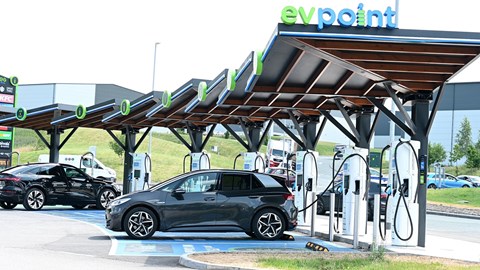
EG Group is also planning to rapidly expand its evpoint network. Currently, the company has around 600 chargers spread over 189 of its sites – but it’s planning to roll out more than 20,000 chargers across 3600 of its sites, with the first of these new Tesla-sourced chargers set to arrive before the end of 2023.
Rebecca Tinucci, Tesla’s Senior Director of Charging Infrastructure, commented on the partnership, saying: ‘The rapid installation of reliable, easy-to-use EV charging infrastructure is the right step towards a sustainable future and a key area of focus for us at Tesla. For this reason, we’re excited to make our fast-charging hardware available for purchase to EG Group, and other leaders in the space.’
Tesla Supercharger trial: allowing other brands to charge up
The partnership with EG Group might be the first time Tesla has sold its charging tech to a third party, but it isn’t the first time Tesla has allowed other EV brands to use its network. In May 2022, Tesla launched a trial in the UK that allowed non-Tesla electric cars to use the Supercharger network.
Elon Musk announced the trial in 2021. He rolled it out in the Netherlands first, eventually adding Spain, Belgium, Sweden and certain Superchargers in the UK. The firm claimed that, by autumn 2023, more than 70% of Tesla chargers across Europe were open to any brand of EV.
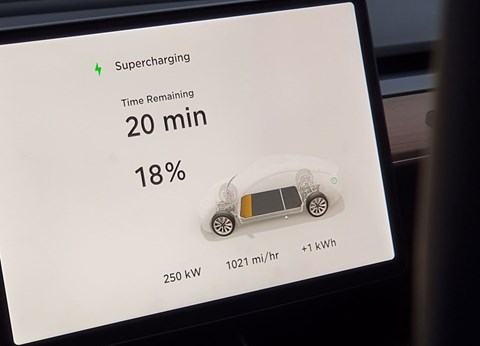
Tesla says it is ‘closely monitoring each site for congestion’ having promised its customers that further stations would only welcome other EVs if there was ‘available capacity.’ The last thing it wants is to annoy its existing, surprisingly evangelical user base.
How do non-Tesla drivers charge up at a Supercharger?
Non-Tesla owners can start Supercharging in selected locations by downloading the Tesla app. When the pilot scheme was originally launched, non-Tesla drivers were charged more than Tesla drivers, paying around 77p per kilowatt hour versus the then 67p per kWh standard rate enjoyed by Tesla drivers – but that was rolled back in winter 2022/23, as Tesla standardised the rate for all its users.
Tesla also states its charging costs can be ‘lowered with a charging membership, ’ which costs £10.99 a month in the UK. Full details of how to charge are here and it’s worth noting that costs are revised regularly.
The scheme was launched with just 15 Tesla Supercharger stations in Great Britain opened to any EV driver. That was a total of 158 Superchargers or around one in four sites, the company said. However, when the scheme was announced, Tesla said: ‘We will eventually welcome both Tesla and non-Tesla drivers at every Supercharger worldwide.’
Now there are 42 sites in the UK that are open to all EVs, representing a total of 477 individual Superchargers.
Tell me about Tesla’s latest Supercharger technology
Tesla’s newest V4 Supercharger arrived in the UK in August 2023, bringing with it the latest, fastest charging tech and improved compatibility with other electric vehicles (EVs).
The V4 Supercharger will work with any electric car using the ubiquitous CCS charging standard and promises to deliver up to 250kW charging speeds to those vehicles that can take it. Tesla’s latest charger also comes with contactless card payment and a longer 3m charging cable for ease of use; V3 chargers rely on payment via the Tesla app.
The first new-generation charger was installed at the Tesla centre in Tottenham, London.
How many Tesla Superchargers are there in the UK?
Tesla now has over 1400 Superchargers in more than 140 locations across the UK and Ireland. Nine years after the first Tesla Supercharger ‘stall’ went live at the Royal Victoria Dock in London in 2014, the 1000th example was opened in 2022 at the London Sidcup Supercharger location at Ruxley Manor, just off the A20.
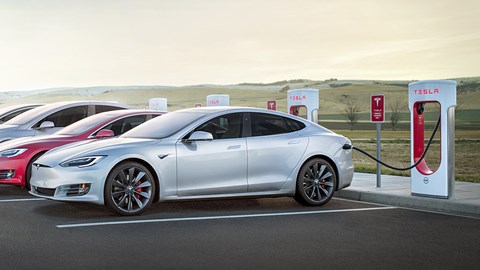
Tesla’s Superchargers can be found throughout the UK mainland – as well as across Europe and beyond – and it’s widely judged as one of the best public charging solutions available. Tesla claims its UK chargers boast an ‘uptime’ (working, without errors) of 99%. An impressive stat.
The company’s network has grown significantly across the continent since it launched in August 2013. There are more than 1100 sites across Europe, with 14,000 individual Superchargers.
Rapid Tesla Supercharger network growth
Back in 2020, Tesla installed its 500th UK Supercharger on the A12 outside Colchester. By 2021, that number increased to 624 chargers across 73 locations. By the time autumn 2023 rolled around there were more than 1100 Supercharger stalls – as Tesla officially calls them – in over 110 locations. You can see how swiftly progress is moving here.
The Supercharger network is one of the main reasons that Tesla electric car ownership has been so viable, even for early adopters; it works seamlessly and hasn’t suffered from the reliability issues that some other networks are notorious for.
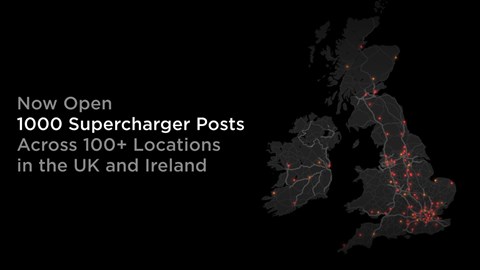
Superchargers can add up to 172 miles of range in just 15 minutes, according to Tesla’s claims and CAR magazine has always found them fast and easy to use.
You’ll have seen the banks of futuristic-looking white stalls at motorway service stations dotted around the UK’s main trunk road network. Owners can see where the stations are on their car’s built-in sat-nav, which also indicates which chargers are in use and which are unoccupied. So while the cost of charging an electric car continues to rise as energy prices keep climbing, Tesla does at least show how to make it as convenient as possible.
What is the Tesla V3 Supercharging?
Before the new V4 Supercharger was rolled out in 2023, it was all about the V3 Supercharger. It used the same principle as Tesla’s previous Superchargers, but added a 1MW power cabinet to the equation. That means 250kW peak charging rates per car, with Tesla saying a Long Range Model 3 can theoretically top up 75 miles of range in just five minutes.
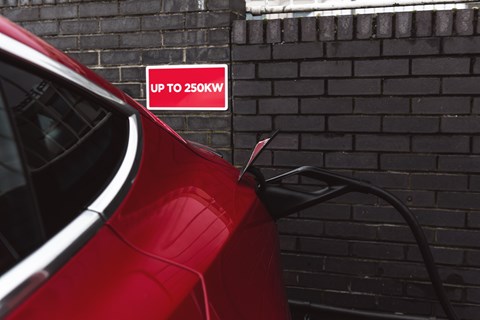
One of the key improvements with V3 and V4 charging was tech meaning that your car never had to share power – so charging speed won’t be hindered when two Teslas charge up next to each other. Handy for those peak busy hours.
The UK’s first V3 Superchargers were installed at Park Royal in London in 2019, using CCS cables that have become the norm on other high-speed charging networks. These can plug into the Model 3 and Model Y directly, while the Model S and Model X are supplied with adaptors. As a result the latter pair will only enjoy maximum charging rates of around 145kW.
Any other recent changes?
Alongside the infrastructure upgrades with V3, Tesla also rolled out an over-the-air update called On-Route Battery Warm-up. Batteries are essentially portable chemical reactions, and their efficiency is sensitive to heat.
Tesla’s new warm-up feature gets the cells at the ideal temperature for charging on the way to the charger, and that means when the car is connected to the Supercharger, power transfer is as efficient as possible – right from the start. The result? More miles for your time stationary.
In 2019, Tesla announced that its V2 Superchargers would be upgraded to unlock charging speeds of up to 145kW. The UK network is a mix of V2, V3 and V4 Superchargers and is undergoing a constant evolution to modernise the hardware.
How much does Supercharging cost?
This has become a bit of a minefield over the years. All Tesla EVs used to come with free Supercharging, but lately the company has been phasing that offer out… before reintroducing it for certain periods to entice new customers. Our advice is to check before you buy, especially if you’re looking at secondhand models.
Charging costs vary, especially in the current climate of volatile energy prices. Tesla now offers its flexible pricing model across the UK Supercharger network – bringing off-peak charging at 54p per kilowatt hour for most of the day, ramping up to 67p between 4pm-8pm every day of the week.
The company pledges to adjust those prices regularly, as the cost of energy changes in the coming weeks. The prices are standard for owners of Teslas and other brands using the network.
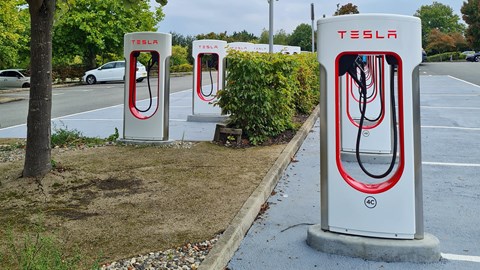
When running a Tesla Model S long-termer back in 2018, CAR consumed £294 of power over 5600 miles, the equivalent of just 5p a mile. That’s cracking value and the (since discontinued) 85D’s 200-mile usable range meant we could easily take it on long trips to the other end of the country – so long as we factored in charging times and the detours occasionally required to find working charging points on our way.
However, in September 2022 there’s increasing evidence to suggest that electric car charging costs have reached parity with petrol and diesel on some public charging networks. So you may need to do some careful maths to work out whether the guide prices of 67p per kWh for Tesla drivers and 77p per kWh for non-Tesla drivers makes economic sense. If you’re able to charge at home, and can access off-peak pricing on a dedicated EV charging electricity tariff, electric cars remain the cheapest choice, however.
Tesla also now charges idle fees; in a bid to stop drivers plugging in and hogging a cable even past full charge while they tuck in to a meal or work in a service station, the company will now charge a premium for drivers who don’t unplug once their battery is full.
How to plan a trip with Tesla Superchargers
Tesla has launched a journey planner which helps you map out any route with your EV. And because the tool is specific to Tesla, it’s able to carefully calculate your route based on the range of your actual car. It’ll also favour Tesla’s own speedier Supercharger network, too. You can try the tool out here.
With every new Supercharger station that comes online that task gets easier and easier, and the Model 3 Long Range’s 374-mile range has massively reduced the need to stop en route. But be warned: there are still large swathes of rural Britain where charging up is not as easy as it should be.